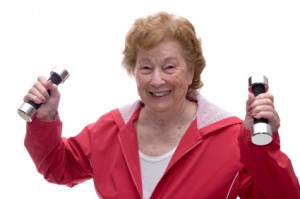Our ancestors were hunters and gatherers, constantly on the go. They did not have to think too much about their muscle and joint health, they simply moved them. In our society this has changed a lot. At work we spend hours sitting at a desk, and then we use computers and watch television at home. Instead of walking to the neighborhood store, we use our car.
Here I will review what we can do to keep our joints and muscles in top shape until a ripe old age.
Brief intro regarding the anatomy of joints and muscles
Our joints are designed to give us full mobility. But the joints cannot do it alone. The muscles are designed to allow the joints to move in a full range. Without exercise the muscles will shrivel up (medical term “atrophy”) within only 2 to 3 weeks. So without regular exercise your joints won’t do you any good. Besides the joint capsules need regular stretching in full range exercises to produce the lubricating fluid (synovial fluid) that nourishes the joint surfaces and the menisci of the knees. Think of muscles and joints as being a functional unit designed to move you about.
Our joints have aerodynamic designs to do the most optimal job for our body. For instance the knees have more of a hinge design that includes menisci for shock absorption while the shoulders and hips have more of a ball and socket type construction.
Wear and tear with aging
It is usually thought that injuries and aging wear down the joints. But there are other factors such as the wide spread use of statins that can contribute to muscles weakness. Ironically statins are taken to protect the heart, but side effects can interfere with the ability to exercise your heart because of aching muscles and joints.
With optimal nutrition and avoidance of wheat and wheat products to prevent autoimmune arthritis (lupus, rheumatoid arthritis, dermatomyositis) your joints can stay young for much longer (explained further below). But your joints and muscles need to move through a full range of motion regularly to keep the blood circulation and nutrition of their tissues in top shape.
What causes joint deterioration?
Aging, weight gain, diabetes, smoking and lack of exercise all are known to cause a worsening of arthritis, particularly osteoarthritis, but also rheumatoid arthritis. The wrong diet with lots of sugar and starch and trans fats (hamburgers, pasta, sugar soda drinks) causes hyperinsulinemia (insulin overproduction, like in type 2 diabetes) and is almost guaranteed to make you sick with arthritis, obesity and diabetes.
There is also evidence that wheat causes inflammation and arthritis by stimulating your pancreas to produce too much insulin. This has been proven for dogs and for humans. A good diet book to follow is Dr. William Davis “Wheat Belly Cookbook” (Ref. 1) with 150 recipes. If you are overweight, these recipes will also help you to lose some weight effortlessly.
A caution to marathon runners: the constant pounding of prolonged jogging can cause osteoarthritis of hips and knees decades down the road. You may want to switch to different exercises before this happens.
What helps joints?
Molecularly distilled omega-3 fatty acid helps to prevent inflammation of your joints. Vitamin D3 will help your bones to be strong to support the tendons and ligaments. Chicken cartilage can build up joint cartilage within a few weeks! So, if you feel pain in your joints use 3 capsules of omega-3 (the strong, molecularly distilled ones) twice per day. This will help your joint inflammation within 3 to 4 weeks. If this alone is not enough add chicken cartilage from the health food store, which will help to build up the hyaline cartilage within your joints. For those who are questioning the effect of chicken cartilage, here is a 1993 chicken cartilage Harvard study proving it.
Below are more general steps that will help your joints, ligaments and muscles.
Maintaining health of joints and muscles
a) It starts with good nutrition.
Hamburgers and deep fried French fries will not do the trick. Muscles require protein from meat, fish, poultry and dairy products. If you are a vegetarian you need to become knowledgeable on what essential amino acids are and what combination of vegetables will give you the amino acid composition to build up a full protein.
Joints need ingredients from cartilage, which you find in chicken cartilage (available in health food stores as fikzol (type II cartilage). I you prefer, chicken soup would also give you the ingredients to build up cartilage, but it would require a lot of regular chicken soup consumption to achieve this.
Sugar and starchy foods, which are broken down within half an hour after a meal into sugar in your blood, cause an insulin response from your pancreas. This in turn can cause inflammation in your joints and tendons. It is interesting to note that type 2 diabetes and arthritis are associated. A ketogenic, low sugar/starch diet will prevent arthritis and diabetes as it reduces the insulin level in the blood, which in turn turns off inflammation in the joints.
b) Supplements:
Omega-3 fatty acids will help control any inflammation including the inflammation from arthritis (you need 3 capsules of the concentrated, molecularly distilled fish oil twice per day to achieve this). DMSO gel, available in health food stores in the US, can also be used to rub onto inflamed joints. It will penetrate tissues rapidly, is nontoxic and helps control inflammation along with the omega-3 fatty acids. Regular anti-inflammatory pain relievers (NSAIDs) are harsh on your kidneys and can irritate the gastric lining causing bleeding gastric erosions, so definitely not recommendable.
Glucosamine, chondroitin sulfate, or a combination of both is available in the health food store and has been shown to help with osteoarthritis. I contributes to building up hyaline cartilage.
c) Watch your weight:
It has been shown that the rate of degenerative arthritis (=osteoarthritis) in obese people is much higher when compared to slim people.
d) Exercise:
You need to move your joints, ligaments and muscles every day to maintain their strength and range of motion. A daily workout at home or in a gym is best. I recommend 30 minutes of a treadmill or equivalent (jogging, Stairmaster etc.) as aerobic exercises. Then you need 30 minutes of isometric exercises like a circuit on exercise machines in the gym or dumbbells and expanders (resistance bands) at home. I consider this as the basic fitness routine every day.
Ballroom dancing and Latin dancing or Zumba is also a good combination exercise, which I would recommend on top of the basic exercise. Dancing helps to maintain your balance as well, which is something the older population tends to lose. In addition dancing stimulates your brain cells and makes you less vulnerable to develop dementia in old age.
Other aerobic exercises that can be recommended are walking (brisk walk) and/or intermittent jogging. Swimming has the advantage particularly for arthritis sufferers that you are floating. It allows you to exercise your leg and arm muscles, even if you have some arthritis pains.
e) Pain relief: What could you do for pain relief? I do not like NSAIDs as this will damage your kidneys on the long-term and cause gastric erosions that can bleed massively. Electro acupuncture is very useful for muscle and joint pains and has no side effects. Physiotherapy treatments are useful to recondition your muscles and build up the range of motion of your joints. Chiropractic treatments for back and neck pain will also help. Instead of narcotics, why not try low dose Naltrexone (LDN). It has been shown to help with the pain of fibromyalgia.
Conclusion
In this brief review I have attempted to show you that your body is not on a one-way street in the direction of disability and death. There is a lot we can actively do to prevent this from happening prematurely. Just eat right, supplement (if you have symptoms), exercise and be active. Soon you will no longer be aware of your previously achy joints or muscles, as the pain tends to melt away when you are reconditioned.
More information on fitness: http://nethealthbook.com/health-nutrition-and-fitness/fitness/
References:
1. William Davis, MD: “Wheat Belly Cookbook. 150 Recipes to Help You Lose the Wheat, Lose the Weight, and Find Your Path Back to Health”. HarperCollins Publishers LTD., Toronto, Canada, 2012.
Last edited Nov. 7, 2014








